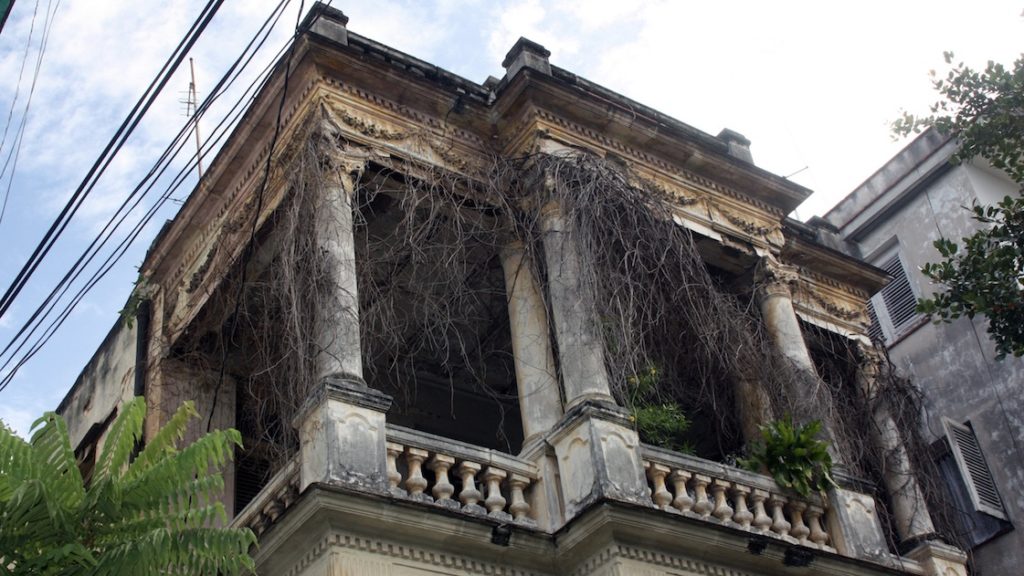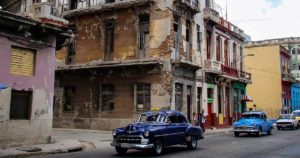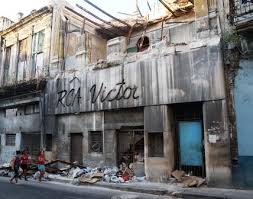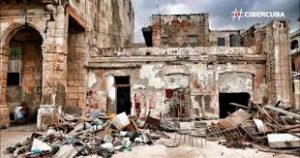 (OPINIÓN) LA HABANA, CARA Y ESPEJO DE TODA CUBA.
(OPINIÓN) LA HABANA, CARA Y ESPEJO DE TODA CUBA.
‘No hay en la historia moderna otra capital que, sin haber sufrido una guerra o devastadoras catástrofes naturales, haya retrocedido tanto como La Habana.’
Fue Cicerón quien dijo hace más de 2.000 años que “la cara es el espejo del alma”. Parafraseando al ilustre romano, La Habana es la cara y espejo de la “revolución” castrista. Es el rostro más visible del país, como Montevideo es la cara de Uruguay, o Londres la de Inglaterra.
Luego de casi 62 años de involución fidelista-raulista, La Habana es un lejano fantasma de lo que fue. Es una ciudad decadente que en buena medida semeja a una anciana abandonada, pobre y achacosa. Suelta los pedazos lastimosamente. Solo en 2020 han muerto siete habaneros aplastados al derrumbarse los edificios en que vivían.
Y no hablamos por error de Kabul o Adis Abeba, sino de una urbe que fue famosa mundialmente por su belleza y encanto singular. Desde los años 20 del siglo pasado en la prensa internacional y en decenas de películas de Hollywood se comentaba que era La Habana la más subyugante ciudad de Latinoamérica por su glamour, su arquitectura, sus luces, su magia contagiosa. Para muchos superaba a Rio de Janeiro, su principal competidora.
Una crónica publicada en marzo de 2010 por un historiador estadounidense en el sitio Antiqueweek comienza así: “No había otro lugar en el hemisferio occidental comparable a Cuba” . Y hace una minuciosa descripción de La Habana entre 1950 y 1960 cuando, según el artículo, la capital cubana era “the playground of the rich and famous”, o sea, “lugar de encuentro de ricos y famosos”, de todo el mundo.
Cuando Conrad Hilton fue a inaugurar personalmente el Habana Hilton en marzo de 1958 dijo que había sido muy acertado escoger a la atractiva Habana para construir el más grande, hermoso y mejor hotel de toda América Latina, y el mayor de esa cadena hotelera a nivel mundial.
Christian Dior, quizás el más famoso modista de todos los tiempos, tenía solo dos salones de moda suyos fuera de París, uno en Nueva York, y el otro en La Habana. Dior tenía miedo a los aviones y la única vez que se montó en uno fue para viajar a La Habana, en 1950, a inaugurar su exclusivo Salón Francés Christian Dior, en El Encanto, la más grande, exclusiva y mejor tienda por departamentos de América Latina, a la que iban a vestirse muchas celebridades de Hollywood.
Lo curioso era que se trataba de la capital de un país pequeño, lo cual expresaba el empuje económico y socio-cultural de Cuba.
A LA VANGUARDIA DE LA TECNOLOGIA MUNDIAL.
Poquísimos saben hoy en la Isla que en 1906 La Habana fue la primera ciudad del mundo con telefonía con discado directo sin necesidad de una operadora. Tampoco que el primer tranvía eléctrico que se conoció en Latinoamérica circuló en la Habana en el año 1900, ni que ese mismo año, antes que a ningún otro país de Latinoamérica, llegó a la Habana el primer automóvil.
Ya en 1837 había sido La Habana la primera ciudad (y país) de América Latina y tercera del mundo (tras Inglaterra y EEUU) en disponer de transporte ferroviario (Habana-Bejucal) de pasajeros y de carga. La primera demostración mundial de una industria movida por electricidad fue en La Habana en 1877. Y 12 años después la ciudad tuvo el primer sistema de alumbrado público de toda Iberoamérica, incluyendo a España.
El primer edificio del mundo construido con hormigón armado fue el FOCSA, en 1952. En 1953 se construyeron en Radiocentro los más modernos estudios de televisión a nivel mundial en ese momento: los de la CMQ. Y en 1951 fue La Habana la primera ciudad a nivel mundial en tener aire acondicionado central en un hotel, el Riviera.
En 1958 fue La Habana la segunda ciudad (y país) en tener televisión en color y crear un canal solo a color. Y en 1957 fue la segunda urbe en tener cine en tercera dimensión y multipantallas, en el cine Radiocentro (hoy Yara). Ya antes, La Habana había sido, en 1922, la segunda urbe (y país) en el mundo en tener una emisora de radio (PWX). Y a fines de los 50 contaba con más automóviles y televisores por habitante que cualquier otra capital latinoamericana.
TODOS ESTOS DATOS SE PUEDEN CONSULTAR EN LA INTERNET.
El servicio de transporte público era eficientísimo. Había miles de ómnibus que pasaban uno casi pegado al otro. Recuerdo que en la esquina de Infanta y San Lázaro paraban unas diez rutas de guaguas hacia todos los puntos de la capital, por ocho centavos.
Vibrante vida nocturna, y más salas de cine que en Nueva York
La Habana era igualmente famosa por su vibrante vida nocturna. Contaba con el cabaret más espectacular del mundo —Tropicana— y cientos de night clubs; y con grandes parques de diversiones como Coney Island y otros.
El teatro Blanquita, con 5.500 butacas era a principio de los años 50 el auditorio de más capacidad bajo techo en el mundo.
Los automóviles nuevos de General Motors, Chrysler y Ford se vendían primero en La Habana que en muchas ciudades de Estados Unidos y del resto del mundo.
Y créalo o no, La Habana tenía más salas de cine que Nueva York y París. Según el Anuario Cinematográfico y Radial Cubano de 1959, al finalizar el año 1958 había en la ciudad 121 salas de cine, cifra que superaba las de las dos urbes más famosas del planeta. Y eso sin contar los cines de Regla, Guanabacoa, Cojímar, Santiago de las Vegas, Jaimanitas, Santa Fe, Arroyo Arenas, y otras ciudades de la Gran Habana. En 1959 yo los conté todos y recuerdo que eran 135, muchos de ellos financiados por Metro-Goldwyn-Mayer, 20th Century Fox y Columbia Pictures.
NINGUNA CAPITAL EN EL MUNDO HA RETROCEDIDO TANTO.
Pero volvamos a la realidad actual. No hay en la historia moderna otra capital que, sin haber sufrido una guerra o devastadoras catástrofes naturales, haya retrocedido tanto como La Habana. Siempre ocurre lo contrario, con el tiempo las ciudades mejoran. Bogotá, y Ciudad de Panamá, digamos, son hoy más hermosas que en 1958.
En La Habana es al revés. Hay cientos de edificios en ruinas, o agrietados y apuntalados con palos, ya a punto de caerse. Y montones de escombros y ruinas por doquier, como en Dresde, Berlín, Tokio, Lídice o Stalingrado al terminar la II Guerra Mundial. Y enormes basureros nauseabundos y fétidas aguas albañales por doquier.
Hoy es peligroso vivir en algunas áreas. Se derrumban como promedio tres viviendas diarias, unas 1.000 al año, según reporte oficial. Este año en enero murieron tres niñas de entre 11 y 12 años, aplastadas por un balcón que les cayó encima, en La Habana Vieja. En julio, en Centro Habana, murió un empleado de Servicios Comunales al caerle encima una pared. Ese mismo mes en El Cerro murió la anciana María Magdalena Olivares, sepultada por su vivienda.
En septiembre de 2020, en La Habana Vieja, murieron Rosa María Sortís, de 69 años, y una anciana de 74 años llamada Elena, aplastadas por sus respectivas viviendas. Y el 14 de octubre se cayó un edificio de Centro Habana y aplastó tres automóviles, en uno de los cuales había un hombre que se salvó porque estaba en la parte de atrás del vehículo, que resultó menos aplastado.
Pululan en La Habana los barrios insalubres, con casuchas y chozas improvisadas, sin agua potable ni alcantarillado, con zonas inundadas por aguas negras, e invadidos por roedores, mosquitos y cucarachas. Si alguien que estuvo en La Habana en 1958 la visita hoy, no puede creer lo que ve. Por mucho que su guía turístico, el diario Granma, o la TV le hablen de los “logros de la revolución”, se percatará de que le están tomando el pelo grotescamente.
Y mientras más se prolongue la dictadura castrista, más ruinosa se pondrá la ciudad. Arquitectos, ingenieros, economistas y urbanistas aseguran que cuando cese la pesadilla comunista se necesitarán miles de millones de dólares para reconstruirla y devolverle su majestuosidad. Y elaboran ideas, y proyectos de cómo emprender esa colosal tarea.
Hoy los habaneros evocan a Góngora: “ayer maravilla fui, y hoy sombra de mí no soy”. Pero como la mitológica Ave Fénix, La Habana renacerá.
 (OPINION) HAVANA, FACE, AND MIRROR OF ALL CUBA.
(OPINION) HAVANA, FACE, AND MIRROR OF ALL CUBA.
“There is no other capital in modern history that, without having suffered a war or devastating natural catastrophes, has regressed as much as Havana.”
It was Cicero who said more than 2,000 years ago that “the face is the mirror of the soul.” Paraphrasing the illustrious Roman, Havana is the face and mirror of the Castro “revolution.” It is the most visible face of the country, as Montevideo is the face of Uruguay, or London that of England.
After almost 62 years of Fidelista-Raulista’s involution, Havana is a distant ghost of what it once was. It is a decaying city that largely resembles an abandoned, poor, and ailing old woman. Pitifully drops the pieces. In 2020 alone, seven habaneros have been crushed to death when the buildings in which they lived collapsed.
And we are not talking by mistake of Kabul or Addis Ababa, but of a city that was famous worldwide for its beauty and unique charm. Since the 1920s, the international press and in dozens of Hollywood films have commented that Havana was the most captivating city in Latin America for its glamor, its architecture, its lights, and its contagious magic. For many, it surpassed Rio de Janeiro, its main competitor.
A chronicle published in March 2010 by an American historian on the Antiqueweek site begins like this: “There was no other place in the Western Hemisphere comparable to Cuba.” And he makes a meticulous description of Havana between 1950 and 1960 when, according to the article, the Cuban capital was “the playground of the rich and famous”, that is, “a meeting place for the rich and famous”, from all over the world.
When Conrad Hilton went to personally inaugurate the Habana Hilton in March 1958, he said that it had been very wise to choose attractive Havana to build the largest, most beautiful, and best hotel in all of Latin America, and the largest of that hotel chain worldwide.
Christian Dior, perhaps the most famous dressmaker of all time, had only two fashion salons of his outside of Paris, one in New York, and the other in Havana. Dior was afraid of airplanes and the only time he got on one was to travel to Havana, in 1950, to inaugurate his exclusive French Christian Dior Salon, in El Encanto, the largest, most exclusive, and best department store in America. Latina, which many Hollywood celebrities were going to dress.
The curious thing was that it was the capital of a small country, which expressed the economic and socio-cultural thrust of Cuba.
THE CUTTING EDGE OF GLOBAL TECHNOLOGY.
Very few know today on the island that in 1906 Havana was the first city in the world with direct-dial telephony without the need for an operator. Neither that the first electric tram that was known in Latin America circulated in Havana in 1900, nor that that same year, before any other country in Latin America, the first automobile arrived in Havana.
Already in 1837 Havana had been the first city (and country) in Latin America and the third in the world (after England and the US) to have rail transport (Havana-Bejucal) for passengers and cargo. The first worldwide demonstration of an industry powered by electricity was in Havana in 1877. And 12 years later the city had the first public lighting system in all of Latin America, including Spain.
The first building in the world built with reinforced concrete was the FOCSA, in 1952. In 1953 the most modern television studios in the world at that time were built in Radiocentro: those of the CMQ. And in 1951, Havana was the first city in the world to have central air conditioning in a hotel, the Riviera.
In 1958, Havana was the second city (and country) to have color television and create a color-only channel. And in 1957 it was the second city to have three-dimensional and multi-screen cinema, at the Radiocentro cinema (today Yara). Already before, Havana had been, in 1922, the second city (and country) in the world to have a radio station (PWX). And in the late 1950s, it had more cars and televisions per inhabitant than any other Latin American capital.
ALL THESE DATA CAN BE SEEN ON THE INTERNET.
The public transport service was very efficient. There were thousands of buses that passed one almost right next to the other. I remember that at the corner of Infanta and San Lázaro about ten bus routes to all parts of the capital stopped for eight cents.
Vibrant nightlife, and more movie theaters than in New York
Havana was equally famous for its vibrant nightlife. It had the most spectacular cabaret in the world —Tropicana— and hundreds of nightclubs, and large amusement parks like Coney Island and others.
The Blanquita theater, with 5,500 seats, was at the beginning of the 1950s the auditorium with the largest indoor capacity in the world.
New automobiles from General Motors, Chrysler, and Ford were sold first in Havana than in many cities in the United States and around the world.
And believe it or not, Havana had more movie theaters than New York and Paris. According to the 1959 Cuban Cinematographic and Radio Yearbook, at the end of 1958, there were 121 movie theaters in the city, a number that exceeded those of the two most famous cities on the planet. And that’s not counting the cinemas of Regla, Guanabacoa, Cojímar, Santiago de las Vegas, Jaimanitas, Santa Fe, Arroyo Arenas, and other cities in Greater Havana. In 1959 I counted them all and I remember there were 135, many of them funded by Metro-Goldwyn-Mayer, 20th Century Fox, and Columbia Pictures.
NO CAPITAL IN THE WORLD HAS REDUCED SO MUCH.
But let’s go back to the current reality. There is no other capital in modern history that, without having suffered war or devastating natural catastrophes, has regressed as much as Havana. The opposite is always the case, with time cities improve. Bogotá, and Panama City, let’s say, are more beautiful today than in 1958.
In Havana, it is the other way around. There are hundreds of buildings in ruins or cracked and propped up with sticks, already about to fall. And piles of rubble and ruins everywhere, as in Dresden, Berlin, Tokyo, Lídice, or Stalingrad at the end of World War II. And huge nauseating garbage cans and fetid sewage waters everywhere.
Today it is dangerous to live in some areas. An average of three homes collapses a day, about 1,000 a year, according to an official report. This year in January, three girls between the ages of 11 and 12 died, crushed by a balcony that fell on them, in Old Havana. In July, in Centro Habana, a Communal Services employee died when a wall fell on him. That same month in El Cerro, the elderly María Magdalena Olivares died, buried by her home.
In September 2020, in Old Havana, Rosa María Sortís, 69, and a 74-year-old woman named Elena died, crushed by their respective homes. And on October 14, a building in Centro Habana fell and smashed three cars, in one of which there was a man who was saved because he was in the back of the vehicle, who was less crushed.
Unhealthy neighborhoods swarm in Havana, with shacks and makeshift huts, without drinking water or sewage, with areas flooded by sewage, and invaded by rodents, mosquitoes, and cockroaches. If someone who was in Havana in 1958 visits it today, they cannot believe what they see. No matter how much your tour guide, the Granma newspaper, or the TV tells you about the “achievements of the revolution,” you will realize that you are being grotesquely teased.
And the longer the Castro dictatorship lasts, the more ruinous the city will become. Architects, engineers, economists, and urban planners say that when the communist nightmare ends, billions of dollars will be needed to rebuild it and restore it to its majesty. And they come up with ideas and projects on how to undertake this colossal task.
Today the people of Havana evoke Góngora: “yesterday I was a wonder, and today I am not a shadow of myself.” But like the mythological Ave Fénix, Havana will be reborn.
Agencies/ DDC/ Roberto Alvarez/ Los Angeles/ Internet Photos/ Arnoldo Varona/ www.TheCubanHistory.com
THE CUBAN HISTORY, HOLLYWOOD.










